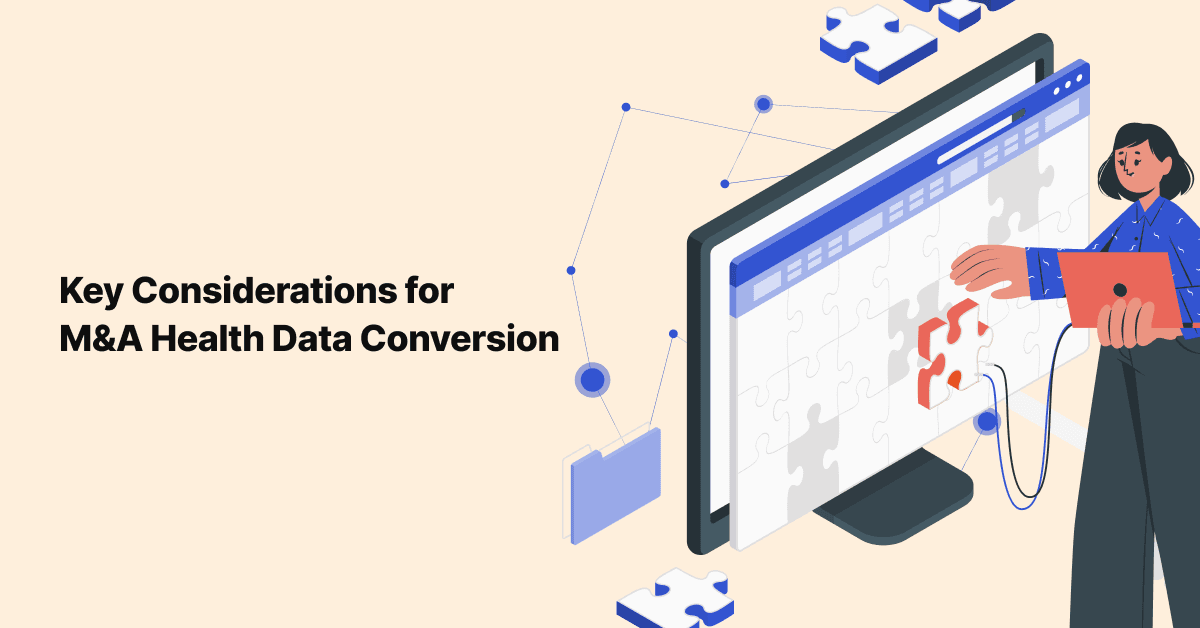
The “What to Consider” List for Health Data Conversion During M&A
Healthcare has witnessed a significant increase in Mergers and Acquisitions (M&As) in the last decade. One …

According to Gartner, 83% of data migration projects either fail or exceed their budgets and schedules. This high failure rate is the reason why migrating Electronic Health Records (EHR) data is a huge challenge for any healthcare organization. Not only is there the logistical challenge of transferring all that data, but ensuring that it’s accurately migrated is critical. There are many common pitfalls with EHR data migration – here are the 10 biggest ones:
Putting together the right plan needs forward thinking along with the right amount of cooperation from the stakeholders. These two factors often get overlooked in the pre-planning stages of the migration process. This can increase the risks of data integrity issues significantly later on. When critical information is corrupted or lost, it can directly impact the quality of patient care. Providers would be unable to access the data that they would need to guarantee patient safety.
It is important to remember that data integrity issues can affect more than just patient safety in a hospital. If you are migrating data that involves more than just clinical data like billing and scheduling, there is a risk of revenue issues, business interruptions, as well as reputation issues in the long term. Taken together, all of these factors would harm the trust of the providers, the patient-provider relationship, and patient satisfaction.
One of the earliest mistakes made by healthcare organizations is not fully understanding what data is being migrated when the process begins. Healthcare data is complicated, and there are strict guidelines for compliance that are required to be followed. In order to successfully migrate healthcare data, a complete understanding of the quality and quantity of data that is being migrated is extremely essential. Healthcare data can contain numerous inter and intra-organizational data interfaces. Hence, the issues regarding the quality and quantity of data should be comprehended beforehand.
Many times, organizations hesitate in terms of upgrading their network infrastructure for data migration purposes. This is often because they perceive this event as a one-time process. However, most organizations would have to go through migrations of different sizes in the years to come, due to which it is all the more important to scale the network infrastructure.
During a migration process, the data moving via the network can be worth decades. There is a high capacity of network performance needed to support such a volume of data. Traditional wireless infrastructure would not be enough to handle the stress of such full-scale migrations. Organizations, therefore, should decide whether they would want to follow the steps for upgrading their network infrastructure for migration or make use of the migration tools that are provided by some of the biggest cloud vendors.
There are several benefits involved in upgrading the network that is beyond migration. This is one of the first steps that should be completed to strengthen the overall IT infrastructure.
One of the biggest mistakes that most organizations perform is that they do not trust cloud services as much as they could have, even though it is something that is growing rapidly in terms of popularity across the healthcare industry. Because of the elasticity and flexibility of cloud services, it could be an invaluable tool during the process of migration of clinical data, as it can help save money. Organizations, however, would be unable to embrace the cloud fully if they do not have the willingness to consider hybrid deployments.
There are huge benefits involved in standing up the solution of data migration in a cloud. The cloud offers scalability, which helps entities in taking full advantage of all the tools that are required for migrating data successfully and correctly.
There are several risks involved in terms of patient safety during data migration processes. Studies reveal that the transition process to a new EHR is harmful to the confidentiality and safety of patients even after having data security layers in place.
Clinicians are required to have instant access to credible and trustworthy legacy data to ensure patient safety. Several issues crop up during data migration processes pertaining to data distortions, lost or garbled data, usability issues, and difficulty in finding data. These threaten patient safety or even impair the ability of a clinician to meet the care guidelines due to the reason of being less familiar with the new EHR.
The lack of compatibility between the data formats of the new EHR system and the old system can be a serious problem. This occurs at times when EHR data is being migrated to a new system that makes use of a different data format or when data is moved from one EHR system to another, which uses a dissimilar database structure. It can also happen when migration occurs between two systems that have different character encoding.
The human infrastructure during a health data migration process includes the likes of technical and medical staff, consultants, leadership, ancillary personnel, and so on. Working with this human infrastructure requires resource allocation and meticulous planning.
Oftentimes, vendors claim that new systems would reduce the need for IT staff like builders, analysts, and technicians. However, it has been observed that the need for IT staff is continuing to grow. It is important to remember that the process of EHR transition is a huge undertaking. For an EHR migration process to be successful, adequate staff and proper time allocation are necessary.
One of the biggest challenges of EHR migration is that it could be a lengthy process. This becomes specifically true when there is a large quantity of data that requires migration. The time taken to move data from one EHR to another depends upon several factors. This includes the number of target systems and data sources, the size of the data as well as the speed of the internet connection. Hospitals must ensure that they plan out the process properly before migration begins. This helps in toning down the challenge of going through long procedures over a lengthy period.
The process of EHR transition involves multiple interfaces and systems, which increases the level of technical difficulties in the process. New challenges arise in interoperability when various individual sites within the same health system make changes in the configuration that are specific to the site, even if they are making use of products from the same vendor.
Data accessibility, database integrity, new system readability, lack of data standards, data sharing, and data conversion to a new system are some of the challenges of external and internal interoperability. Such technical challenges often emerge during the process of EHR transitions with unexpected vehemence.
The apprehension of physicians regarding learning new workflows and processes could create an obstacle to the effective use of EHR. When physicians approach the process of EHR migration to a new system, they come with some expectations which arise from prior experiences.
Apart from the usual concerns related to addressing their expectations, it has been seen that most clinicians are dissatisfied with the requirement of documenting history, recreating lists, tracking health maintenance, writing new prescriptions, looking for clinical guidelines, and so on. These are some of the tasks they expect to be completed without requiring their input.
EHR migration is a process that is remarkably laborious, expensive, time-consuming, and personnel devouring. When it comes to healthcare, the consequences of incorrect migration of clinical data are crippling and vast. Entities would not be able to access their data if migration is done improperly. Furthermore, many organizations might not be able to afford the cost and time of correcting the process of migration. Hence, organizations must ensure that they are aware of the common migration mistakes beforehand and build clinical data migration strategies accordingly. One must also remember improper migration of healthcare data can affect the reputation of health organizations as well.
Having a prudent plan can help streamline the process of EHR transitions as well as reduce expenses. Strategies such as managing expectations, preserving legacy data, and hiring specialty consultants on a short-term basis can help in overcoming some of the greatest hurdles in EHR migration.
Join over 3,200 subscribers and keep up-to-date with the latest innovations & best practices in Healthcare IT.

Healthcare has witnessed a significant increase in Mergers and Acquisitions (M&As) in the last decade. One …

Since the release of the Cures Act Final Rule in May 2020, the US healthcare industry has been experiencing a …

Information blocking was brought into action to ensure the patient’s right to access their health data was …